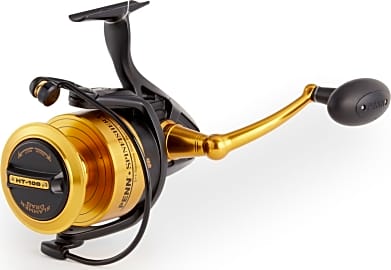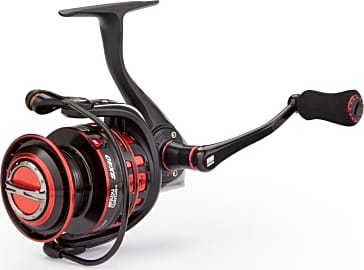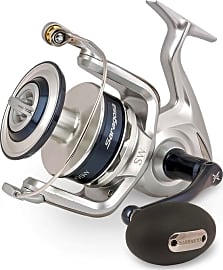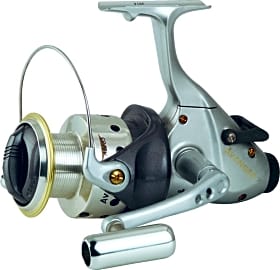The 10 Best Spinning Reels

This wiki has been updated 41 times since it was first published in March of 2015. Heading out on a fishing expedition? With one of these spinning reels, you'll be prepared to haul in catch after catch. We've included affordable models for budget-minded anglers as well as the latest in graphite and carbon fiber technology for exceptional performance and durability. Stop talking about "the one that got away" and start stockpiling photos of your conquests. When users buy our independently chosen editorial choices, we may earn commissions to help fund the Wiki.
Editor's Notes
October 28, 2020:
We looked over the Penn Battle II, noting that it allows for speedy retrieval despite its somewhat heavy frame. We moved this item up in the rankings. We also highlight that the finish on the Okuma Avenger ABF is pretty sleek, making it look more expensive than it is (it’s actually quite affordable). Although we confirmed that the Pflueger President is indeed an effective reel, we slightly downgraded it upon learning that some anglers find it to lack the smooth retrieval they’re accustomed to.
We adjusted the listing for the Daiwa BG to reflect the latest version of this item, noting its easy-to-use screw-in handle that can be positioned for both left- and right-handed fishermen.
They’re a bit more expensive than most of the items on the list, but the IRT Reels of the Special Honors section are likely to impress even your most intense fishing buddies. There’s a wide range of styles available (both single and dual drag), all of which are super sleek and come with a hard travel case.
May 06, 2019:
Eliminated the Abu Garcia Orra SX due to availability issues. We updated the Penn Spinfisher to the latest version (VI), and we also increased its ranking after discovering consistent positive user feedback highlighting its strengths (low-effort long casts, resistance to saltwater, and a high-quality gear oscillation system) as well as its lack of irksome tendencies (getting gnarled up in the wind, for example).
Also gave the Daiwa Black Gold a bump. Users appreciate its performance and stability when it comes to targeting large, heavy species, thanks primarily to a heavy-duty drag system that operates smoothly without binding up.
The KastKing Sharky III was the only new addition. We wanted to provide a high-value model suitable for novices and veteran anglers alike, and this option fits the bill. Several users are surprised at how smooth and balanced the casting and reeling process is, especially when used extensively in saltwater conditions. Those who fish in the surf will want to consider this model, as its rubber grips make it easy to handle when it’s wet.
Special Honors
Eagle Claw EC Series Wright & McGill Co., which began as a fishhook maker in Denver back in 1925, has since added a line of high-quality spinning reels to its fishing gear portfolio. This stylish black-and-red model is available in four sizes — and you’ll be able to customize it by weight and retrieval rate. eagleclaw.com
IRT Reels Known for their heavy-duty drag system and super-tough construction, IRT spinning reels are used by hardcore saltwater and freshwater fishermen across the globe. You can choose from a variety of styles and color schemes, and every model comes with a wrench, lubricant, grease and a microfiber towel. irtreels.com
A Reel For Every Fisherman
Then the angler can begin reeling again when the fish takes a break.
Spinning reels are the most popular type of fishing reel in use today, most likely because of their ease of use and versatility. Unlike traditional baitcasters, it doesn't take much skill to learn how to use one, and the chances of winding up with a messy bird's nest, which is what fisherman call a knotted up mess of line resulting from poor casting technique, are relatively slim. Depending on the build quality and size of the reel, they can be used in salt or freshwater, for catches big and small, and for everything from trolling to finesse fishing.
In addition to their completely open design and horizontal orientation, one of the main things that separates a spinning reel from a traditional baitcaster or fly reel is the fixed-spool. In a spinning reel, the spool never moves and instead the line is retrieved by the bail and line roller spinning around the spool. On most other types of fishing reels, except for a spincaster, the actual spool will rotate.
All spinning reels have a drag system that allows the fisherman or women to set the amount of resistance a fish feels when it bites on the line. The tighter the drag is set, the more resistance a fish feels, and vice versa. Drag systems also help when fighting a fish. True anglers know that using the lightest tackle possible not only makes for more fun, but also gives the user a better feel for what is happening on the other end of the line and makes it easier to present lures in the most lifelike fashion possible. In addition, light tackle reduces the chances of a fish seeing or sensing the line and becoming spooked.
Unfortunately, this also means that fisherman are often landing fish capable of breaking their line if they run at full power in the opposite direction. The drag system can be set for a certain resistance level so that instead of the line breaking when a fish runs, the spool feeds out more line. Then the angler can begin reeling again when the fish takes a break. This give and take wears out the fish so that it can eventually be pulled up to the boat or shoreline. If handled correctly, a fisherman can even land large game fish on light tackle.
Choose Your Reel Carefully
If you are planning to go fishing and are in the market for a quality spinning reel, there are several factors you should consider before making your final purchase.
First, you can choose from a front drag or rear drag spinning reel. In general, front drag reel models are the best performers and hold up the longest to continuous use. They are best for going after that big catch that you brag about to all of your buddies. The rear drag model, while not as durable and long-lasting, is easier to use and might be the best choice for someone who has never used a spinning reel before.
With some spinning reels, you can even choose a gear system where you have the option to switch from high to low gears.
Second, check for the number of ball bearings your spinning reel has. Most quality reels use stainless steel ball bearings, and the more ball bearings, the better the reel performs.
Third, make sure you check the gear ratio. This means finding out how many times the reel spins each time you turn the handle. The higher the gear ratio, the better the reel. With some spinning reels, you can even choose a gear system where you have the option to switch from high to low gears.
Fourth, find out what material your reel frame and spool are made of. If they are made from aluminum, they will be heavier but more durable and more likely to hold up in the event of a big catch. If they are made of graphite, they are lighter weight and less prone to wear, but they are not as strong and can break under too much pressure.
Fifth, check for balance and comfort. The reel and rod need to be the right fit for your hands, and you need to be able to operate it comfortably. Even if it has all other elements that you want, if it feels too large or cumbersome or too small and flimsy, it's probably not the right reel for you.
Finally, consider where you plan to use it. Are you fishing on the open ocean, or do you plan to stick to fast moving rivers? Where you intend to fish and what type of fish you intend to catch will help you make your final decision.
A Brief History Of The Spinning Reel
Written evidence of fishing reels date back as far as the 4th century. Throughout the centuries, fishing reels were depicted in Chinese and Armenian artwork. In 1651, a version of the fishing reel was mentioned in "The Art of Angling." There is evidence of fishing rods dating back as far as 2,000 B.C. depicted on stone in Egypt, China, Greece and other ancient civilizations.
Today, there are many popular reel companies that develop and sell high-quality spinning reels offering a wide range of options from which consumers can choose.
During the English civil war, fly fishing began to become popular. Several books were published over the next fifty years on the art of fishing and angling and the best ways to catch the biggest fish. This is when fishing rods and reels began to see a rise in development.
Spinning reels were first used in North America in the 1870s. They were created so they could be used with fishing flys or other types of lures to catch freshwater fish such as salmon or trout. They also helped to prevent the line from tangling during backlash if a fish slipped the line.
It wasn't until 1948 that an advanced type of spinning reel was introduced by Mitchell Reel Company in France. It was called the Mitchell 300, and it fixed the reel permanently to the rod and was offered in a wide variety of types and sizes for fishermen in both fresh water and salt water.
Today, there are many popular reel companies that develop and sell high-quality spinning reels offering a wide range of options from which consumers can choose.















